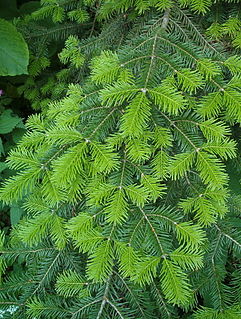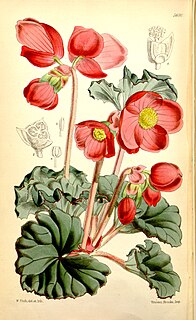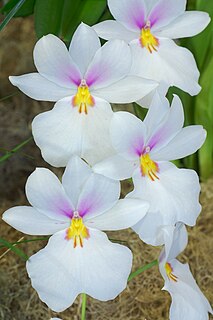
Ruminants are large hoofed herbivorous grazing or browsing mammals that are able to acquire nutrients from plant-based food by fermenting it in a specialized stomach prior to digestion, principally through microbial actions. The process, which takes place in the front part of the digestive system and therefore is called foregut fermentation, typically requires the fermented ingesta to be regurgitated and chewed again. The process of rechewing the cud to further break down plant matter and stimulate digestion is called rumination. The word "ruminant" comes from the Latin ruminare, which means "to chew over again".

Abies veitchii, also known as Veitch's silver-fir, is a fir native to Japan on the islands of Honshū and Shikoku. It lives in moist soils in cool wet mountain forests at elevations of 1500–2800 m. It is very shade-tolerant when young, but is not long-lived.

Nepenthes veitchii, or Veitch's pitcher-plant, is a Nepenthes species from the island of Borneo. The plant is widespread in north-western Borneo and can also be found in parts of Kalimantan. Nepenthes veitchii usually grows as an epiphyte, though the form from Bario seems to be strictly terrestrial and has not been observed to climb trees.

The Veitch Nurseries were the largest group of family-run plant nurseries in Europe during the 19th century. Started by John Veitch sometime before 1808, the original nursery grew substantially over several decades and was eventually split into two separate businesses—based at Chelsea and Exeter—as it became unfeasible to run the whole operation from one location. Famous plant hunters in the Victorian period employed by the Veitch family include the brothers Thomas Lobb and William Lobb from Cornwall and David Bowman.

Sir Harry James Veitch was an eminent English horticulturist in the nineteenth century, who was the head of the family nursery business, James Veitch & Sons, based in Chelsea, London. He was instrumental in establishing the Chelsea Flower Show, which led to him being knighted for services to horticulture.

Peter Christian Massyn Veitch was a member of the family of horticulturists who established the renowned family business Veitch Nurseries.

John Gould Veitch was a British horticulturist and traveller, one of the first Victorian plant hunters to visit Japan. A great-grandson of John Veitch, the founder of the Veitch horticulture dynasty, he also visited the Philippines, Australia, Fiji, and other Polynesian islands.

James Herbert Veitch F.L.S., F.R.H.S., was a member of the Veitch family who were distinguished horticulturists and nursery-men for over a century.

Gustav Wallis was a German plant collector, who introduced over 1,000 plant species to Europe, many of which were named after him.
Charles Curtis was an English botanist who was sent by James Veitch & Sons to search for new plant species in Madagascar, Borneo, Sumatra, Java and the Moluccas, before settling in Penang, where he became the first superintendent of the Penang Botanic Gardens.
David Burke was one of the most widely travelled plant collectors, who was sent by James Veitch & Sons to collect plants in British Guiana, Burma and Colombia. In his later life, Burke became rather eccentric, preferring the privations of life away from his native England.

Begonia boliviensis is a plant in the begonia family, Begoniaceae, which was introduced to Europe in 1864 by Richard Pearce who discovered it in the Bolivian Andes, although the plant had previously been identified by Hugh Weddell in the same region but not introduced.

Begonia veitchii is a plant in the begonia family, Begoniaceae, which was introduced to Europe in 1866 by Richard Pearce who discovered it in the Peruvian Andes near Cusco at an elevation of from 10,000 feet (3,000 m) and 12,000 feet (3,700 m). It was named after Pearce's employers, James Veitch & Sons of Chelsea, London. It can be found today in the mountains around Machu Picchu. A later plant collector, Walter Davis, found Begonia veitchii inhabiting rocky positions by waterfalls, in company with Masdevallia veitchiana.
Richard Pearce was a British plant collector, who introduced the tuberous begonia to England, which led to the development of the hybrid begonias grown today.
Walter Davis was an English plant collector, who collected in South America for James Veitch & Sons of Chelsea, London.
David Bowman was a British plant collector who, in 1866, was sent by James Veitch & Sons to collect in Brazil. The species Dieffenbachia bowmanii is named after him.

Miltoniopsis vexillaria is a species of epiphytic orchid in the genus Miltoniopsis.

Joseph Henry Chesterton was a British plant collector who was sent by James Veitch & Sons to search for orchids in South America with much success.
Wilhelm (Guillermo) Kalbreyer (1847–1912) was a German plant collector who was sent by James Veitch & Sons of Chelsea, London to collect new plants in West Africa and South America.

William Lobb was a British plant collector, employed by Veitch Nurseries of Exeter, who was responsible for introducing to commercial growers Britain Araucaria araucana from Chile and the massive Sequoiadendron giganteum (Wellingtonia) from North America.














